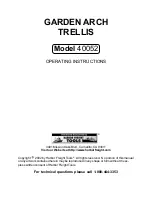
16
BEFORE OPERATING
CHECK COOLING SYSTEM
Clean debris off screen and front of radiator daily, hourly
if conditions are extremely dusty and dirty; refer to
Cleaning Radiator and Screen.
The cooling system is filled with a 50/50 solution of
water and permanent ethylene glycol anti–freeze.
Check level of coolant at beginning of each day before
starting the engine. Capacity of cooling system is
approximately 6 quarts (5.7 L).
1.
Carefully remove radiator cap. Coolant is
pressurized
and may be hot if engine has been running.
2.
Check level of coolant in radiator. Level of coolant
must be above the core and about 1 inch (25 mm) below
bottom of filler neck.
3.
If coolant level is low, replenish the system. DO
NOT OVERFILL.
4.
Install radiator cap.
CHECK HYDRAULIC SYSTEM OIL
The hydraulic system is designed to operate on any
high–quality detergent oil having the American
Petroleum Institute—API—“service classification”
SE/SF. Oil viscosity—weight—must be selected
according to anticipated ambient temperature.
Temperature / viscosity recommendations are:
Expected
Ambient
Temperature
Recommended
Viscosity
and Type
(Extreme) over 90
F
SAE 30, Type SE/SF en-
gine oil.
(Normal) 40-100
F
SAE 10W-30 or
10W-40, Type SE/SF
engine oil.
(Cool—Spring/Fall)
30-50
F
SAE 5W-30, Type
SE/SF engine oil.
(Winter) Below 30
F
Type “F” or “FA” ATF
Automatic Transmission
Fluid.
Note: Do not mix engine oil and automatic transmission
fluid or hydraulic system component damage may
result. When changing fluids, also change transmission
filter. DO NOT USE DEXRON II ATF.
Note: Fluid to operate the power steering is supplied by
the hydraulic system transmission charge pump. Cold
weather start–up may result in “stiff” operation of the
steering until the hydraulic system has warmed up.
Using proper weight hydraulic oil in system minimizes
this condition.
The front axle housing acts as the reservoir for the
system. The transmission and axle housing are shipped
from the factory with approximately 5 quarts (4.7 L) of
SAE 10W-30 engine oil. However, check level of
transmission oil before engine is first started and daily
thereafter.
1.
Position machine on a level surface, raise the
implement, and stop the engine.
2.
Unscrew dipstick cap (Fig. 15) from the filler neck
and wipe it with a clean rag. Screw dipstick cap finger
tight onto filler neck. Unscrew the dipstick and check
level of oil. If level is not within 1/2 inch (13 mm) from the
groove in the dipstick, add enough oil to raise level to
groove mark. DO NOT OVERFILL by more than 1/2
inch (13 mm) above groove.
Figure 15
1. Dipstick cap
2. Groove
1
2
IMPORTANT: When adding oil to the hydraulic
system, use a funnel with a fine wire screen—200
mesh—and ensure funnel and oil are immaculately
clean. This procedure prevents accidental
contamination of the hydraulic system.
3.
Screw dipstick filler cap finger–tight onto filler neck.
It is not necessary to tighten cap with a wrench.
4.
Lower the implement.
Содержание 30789
Страница 2: ......
Страница 37: ...36 HYDRAULIC SCHEMATIC...
















































